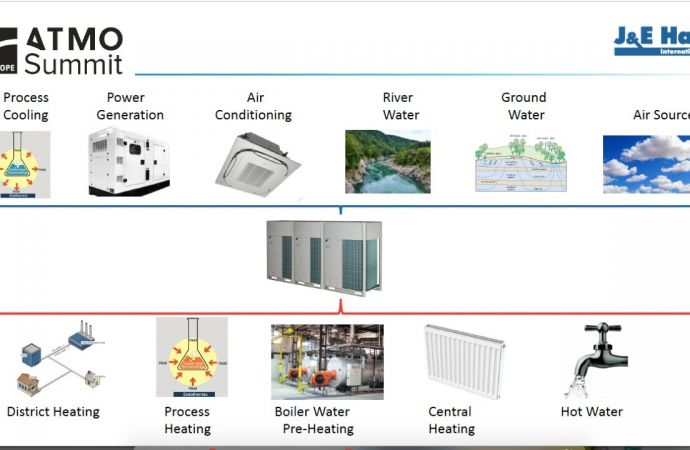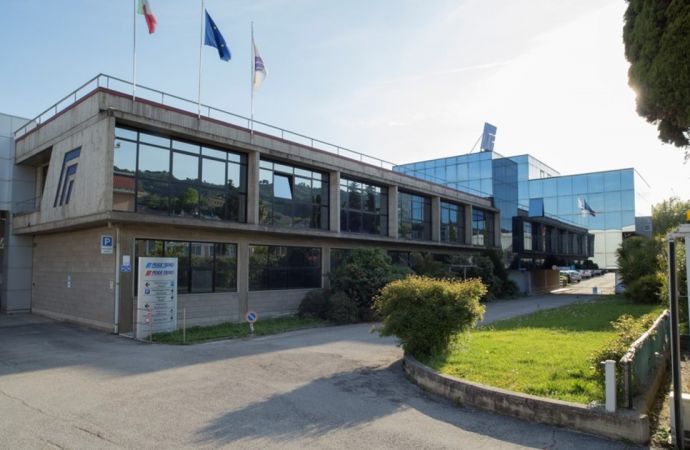A chiller’s waste heat should be used with a heat pump, and not with a gas boiler, says J&E Hall expert.

Sources of heat (top line) should be leveraged by a heat pump to serve a heat sink (bottom line), says J&E Hall.
Using a natural refrigerant heat pump to link a heat source with a heat sink is needed to reduce carbon emissions.
That was the message from Graham McDermott, Director of Process, Marine and Applied Refrigeration at U.K. manufacturer J&E Hall, who spoke at the ATMOsphere Europe conference, which took place online September 28-29. ATMOsphere Europe was organized by ATMOsphere (formerly shecco), the publisher of Ammonia21.com.
“People are starting to understand now, that we can’t just waste the heat that we’ve got,” McDermott said. “When you can take the waste heat from a chiller and use it with a heat pump, instead of a gas boiler, and increase the combined system COP from 1.25 to 6 … that is a no brainer.”
“I think that we need to be more innovative in the way we match our heating and cooling demands, and we can’t treat the two systems as separate anymore, there’s got to be a common solution,” he added.
As examples of good heat sources for heat pumps, McDermott listed industrial process waste heat, air conditioning systems, river and ground water, and even plain old air. Heat sinks that benefit from heat pump systems are, for example, district heating networks, process heating and hot water production.
One of the benefits of heat pumps, compared with heat recovery from chillers, is the higher temperatures that heat pumps are capable of delivering. Thus, heat pumps are suitable for district heating systems, where the water temperatures often need to be from 70 to 80°C (158 to 176°F), McDermott explained.
District heating in Switzerland
An example given by McDermott of how heat pumps can help reduce reliance on fossil fuels and reduce CO2e emissions is a combined power generation and district heating project in Switzerland; this supplies heating and hot water for more than 1,000 homes adjacent to the power plant.
The customer had relied on oil-fired boilers since the 1980s, but J&E Hall designed a new system utilizing an ammonia water-source heat pump with a wood-chip boiler. The system has a capacity from 675kW to 2,450kW and supplies 70°C hot water for the district heating network.
One of the design challenges faced by J&E Hall was that both water-inlet temperature and flow rates are liable to change suddenly. The new system also needed to fit into a quite small space, only 1.8m wide (5ft11in).
The customer had specified a minimum COP of 4.4. After installation and commissioning, the system proved to have a heating COP of 5, almost 15% more than what J&E Hall had promised the customer. The new system also minimized the use of the oil-fired boilers, and increased the share of renewable energy from 50% to over 70%.
Part of the Daikin Group, J&E Hall is based in the U.K., but carries out contracts worldwide. The company has a long history, producing its first “cold air” machines in 1875, and its first ammonia compressor in 1892. It manufactures screw compressors, compressor racks and low-charge ammonia chillers, among other products.
People are starting to understand now, that we can’t just waste the heat that we’ve got.”– – Graham McDermott, J&E Hall
Want to find out more, or have something to say about this story? Join the ATMO Connect network to meet and engage with like-minded stakeholders in the clean cooling and natural refrigerant arena.
Related stories




